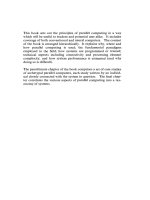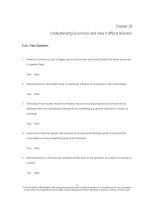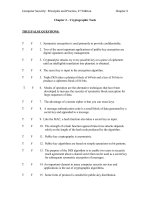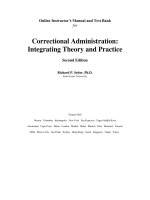Giáo trình derivatives principles and practice 2nd sundaram
Bạn đang xem bản rút gọn của tài liệu. Xem và tải ngay bản đầy đủ của tài liệu tại đây (12.44 MB, 1,002 trang )
Second Edition
DE RI VAT IV ES
PRINCIPLES and PRACTICE
R a n g a r a j a n K . S u n d a ra m
Sanjiv R. Das
Derivatives:
Principles and
Practice
The McGraw-Hill/Irwin Series in Finance, Insurance, and
Real Estate
Stephen A. Ross
Franco Modigliani Professor of Finance and Economics
Sloan School of Management
Massachusetts Institute of Technology
Consulting Editor
FINANCIAL MANAGEMENT
Block, Hirt, and Danielsen
Foundations of Financial Management
Fifteenth Edition
Brealey, Myers, and Allen
Principles of Corporate Finance
Eleventh Edition
Brealey, Myers, and Allen
Principles of Corporate Finance, Concise
Second Edition
Brealey, Myers, and Marcus
Fundamentals of Corporate Finance
Eighth Edition
Brooks
FinGame Online 5.0
Bruner
Case Studies in Finance: Managing for
Corporate Value Creation
Seventh Edition
Cornett, Adair, and Nofsinger
Finance: Applications and Theory
Third Edition
Cornett, Adair, and Nofsinger
M: Finance
Third Edition
DeMello
Cases in Finance
Second Edition
Grinblatt (editor)
Stephen A. Ross, Mentor: Influence
through Generations
Grinblatt and Titman
Financial Markets and Corporate
Strategy
Second Edition
Higgins
Analysis for Financial Management
Eleventh Edition
Kellison
Theory of Interest
Third Edition
Ross, Westerfield, and Jaffe
Corporate Finance
Tenth Edition
Ross, Westerfield, Jaffe, and Jordan
Corporate Finance: Core Principles
and Applications
Fourth Edition
Ross, Westerfield, and Jordan
Essentials of Corporate Finance
Eighth Edition
Ross, Westerfield, and Jordan
Fundamentals of Corporate Finance
Eleventh Edition
Shefrin
Behavioral Corporate Finance: Decisions
that Create Value
First Edition
White
Financial Analysis with an Electronic
Calculator
Sixth Edition
INVESTMENTS
Bodie, Kane, and Marcus
Essentials of Investments
Ninth Edition
Bodie, Kane, and Marcus
Investments
Tenth Edition
Hirt and Block
Fundamentals of Investment Management
Tenth Edition
Jordan, Miller, and Dolvin
Fundamentals of Investments: Valuation
and Management
Seventh Edition
Stewart, Piros, and Heisler
Running Money: Professional Portfolio
Management
First Edition
Sundaram and Das
Derivatives: Principles and Practice
Second Edition
FINANCIAL INSTITUTIONS AND
MARKETS
Rose and Hudgins
Bank Management and Financial Services
Ninth Edition
Rose and Marquis
Financial Institutions and Markets
Eleventh Edition
Saunders and Cornett
Financial Institutions Management:
A Risk Management Approach
Eighth Edition
Saunders and Cornett
Financial Markets and Institutions
Sixth Edition
INTERNATIONAL FINANCE
Eun and Resnick
International Financial Management
Seventh Edition
REAL ESTATE
Brueggeman and Fisher
Real Estate Finance and Investments
Fourteenth Edition
Ling and Archer
Real Estate Principles: A Value Approach
Fourth Edition
FINANCIAL PLANNING AND
INSURANCE
Allen, Melone, Rosenbloom, and Mahoney
Retirement Plans: 401(k)s, IRAs, and
Other Deferred Compensation
Approaches
Eleventh Edition
Altfest
Personal Financial Planning
First Edition
Harrington and Niehaus
Risk Management and Insurance
Second Edition
Kapoor, Dlabay, and Hughes
Focus on Personal Finance: An active
approach to help you achieve financial
literacy
Fifth Edition
Kapoor, Dlabay, and Hughes
Personal Finance
Eleventh Edition
Walker and Walker
Personal Finance: Building Your Future
First Edition
Derivatives:
Principles and
Practice
Second Edition
Rangarajan K. Sundaram
Stern School of Business
New York University
New York, NY 10012
Sanjiv R. Das
Leavey School of Business
Santa Clara University
Santa Clara, CA 95053
DERIVATIVES: PRINCIPLES AND PRACTICE, SECOND EDITION
Published by McGraw-Hill Education, 2 Penn Plaza, New York, NY 10121. Copyright © 2016 by McGraw-Hill
Education. All rights reserved. Printed in the United States of America. Previous edition © 2011. No part of this
publication may be reproduced or distributed in any form or by any means, or stored in a database or retrieval
system, without the prior written consent of McGraw-Hill Education, including, but not limited to, in any
network or other electronic storage or transmission, or broadcast for distance learning.
Some ancillaries, including electronic and print components, may not be available to customers outside the
United States.
This book is printed on acid-free paper.
1 2 3 4 5 6 7 8 9 0 QVS/QVS 1 0 9 8 7 6 5
ISBN 978-0-07-803473-2
MHID 0-07-803473-6
Senior Vice President, Products & Markets: Kurt L. Strand
Vice President, General Manager, Products & Markets: Marty Lange
Vice President, Content Design & Delivery: Kimberly Meriwether David
Managing Director: Doug Reiner
Brand Manager: Charles Synovec
Product Developer: Jennifer Lohn
Digital Product Developer: Meg Maloney
Director, Content Design & Delivery: Linda Avenarius
Executive Program Manager: Faye M. Herrig
Content Project Managers: Mary Jane Lampe, Sandra Schnee
Buyer: Jennifer Pickel
Cover Design: Studio Montage
Content Licensing Specialists: Beth Thole
Cover Image Credit: © Brand X Pictures/PunchStock
Compositor: MPS Limited
Typeface: 10/12 Times New Roman
Printer: Quad/Graphics
All credits appearing on page or at the end of the book are considered to be an extension of the copyright page.
Library of Congress Cataloging-in-Publication Data
Sundaram, Rangarajan K.
Derivatives : principles and practice / Rangarajan K. Sundaram, Sanjiv R.
Das. – Second edition.
pages cm
ISBN 978-0-07-803473-2 (alk. paper)
1. Derivative securities. I. Das, Sanjiv R. (Sanjiv Ranjan) II. Title.
HG6024.A3S873 2016
332.64’57—dc23
2014037947
The Internet addresses listed in the text were accurate at the time of publication. The inclusion of a website does
not indicate an endorsement by the authors or McGraw-Hill Education, and McGraw-Hill Education does not
guarantee the accuracy of the information presented at these sites.
www.mhhe.com
To my lovely daughter Aditi
and
to the memory of my beautiful wife Urmilla
. . . RKS
To my departed parents
and
Priya and Shikhar
. . . SRD
Brief Contents
Author Biographies
Preface
xvi
xxi
19 Exotic Options II: Path-Dependent
Options 467
1
20 Value-at-Risk
Acknowledgments
1
18 Exotic Options I: Path-Independent
Options 437
xv
Introduction
495
21 Convertible Bonds
22 Real Options
PART ONE
Futures and Forwards
2 Futures Markets
PART THREE
21
Swaps
4 Pricing Forwards and Futures II: Building
on the Foundations 88
5 Hedging with Futures and Forwards
104
6 Interest-Rate Forwards and Futures
126
567
23 Interest Rate Swaps and Floating-Rate
Products 569
24 Equity Swaps
614
25 Currency and Commodity Swaps
651
26 The Term Structure of Interest Rates:
Concepts 653
155
157
27 Estimating the Yield Curve
8 Options: Payoffs and Trading
Strategies 173
29 Factor Models of the Term Structure
10 Early Exercise and Put-Call Parity 216
11 Option Pricing: A First Pass
231
261
13 Implementing Binomial Models
14 The Black-Scholes Model
671
28 Modeling Term-Structure
Movements 688
9 No-Arbitrage Restrictions on
Option Prices 199
12 Binomial Option Pricing
697
30 The Heath-Jarrow-Morton and Libor
Market Models 714
PART FIVE
290
309
Credit Risk
753
31 Credit Derivative Products
755
15 The Mathematics of Black-Scholes 346
32 Structural Models of Default Risk
16 Options Modeling: Beyond
Black-Scholes 359
33 Reduced-Form Models of
Default Risk 816
17 Sensitivity Analysis: The Option
“Greeks” 401
34 Modeling Correlated Default
vi
632
PART FOUR
Interest Rate Modeling
PART TWO
7 Options Markets
547
19
3 Pricing Forwards and Futures I:
The Basic Theory 63
Options
516
850
789
Brief Contents
Bibliography
Index
B-1
I-1
The following Web chapters are
available at www.mhhe.com/sd2e:
PART SIX
Computation
1
35 Derivative Pricing with Finite
Differencing 3
36 Derivative Pricing with Monte Carlo
Simulation 23
37 Using Octave 45
vii
Contents
Author Biographies
Preface
xvi
Acknowledgments
Chapter 1
Introduction
1.1
1.2
1.3
1.4
1.5
1.6
3.8 Futures Prices 75
3.9 Exercises 77
Appendix 3A Compounding Frequency 82
Appendix 3B Forward and Futures Prices with
Constant Interest Rates 84
Appendix 3C Rolling Over Futures Contracts 86
xv
xxi
1
Forward and Futures Contracts 5
Options 9
Swaps 10
Using Derivatives: Some Comments
The Structure of this Book 16
Exercises 17
Chapter 4
Pricing Forwards and Futures II: Building
on the Foundations 88
12
PART ONE
Futures and Forwards
Chapter 2
Futures Markets
19
21
2.1 Introduction 21
2.2 The Functioning of Futures Exchanges 23
2.3 The Standardization of Futures Contracts 32
2.4 Closing Out Positions 35
2.5 Margin Requirements and Default Risk 37
2.6 Case Studies in Futures Markets 40
2.7 Exercises 55
Appendix 2A Futures Trading and US Regulation:
A Brief History 59
Appendix 2B Contango, Backwardation, and
Rollover Cash Flows 62
Chapter 3
Pricing Forwards and Futures I: The Basic
Theory 63
3.1
3.2
3.3
3.4
Introduction 63
Pricing Forwards by Replication 64
Examples 66
Forward Pricing on Currencies and Related
Assets 69
3.5 Forward-Rate Agreements 72
3.6 Concept Check 72
3.7 The Marked-to-Market Value of a Forward
Contract 73
viii
4.1 Introduction 88
4.2 From Theory to Reality 88
4.3 The Implied Repo Rate 92
4.4 Transactions Costs 95
4.5 Forward Prices and Future Spot Prices 96
4.6 Index Arbitrage 97
4.7 Exercises 100
Appendix 4A Forward Prices with Convenience
Yields 103
Chapter 5
Hedging with Futures and Forwards
104
5.1
5.2
5.3
5.4
5.5
5.6
5.7
5.8
5.9
5.10
Introduction 104
A Guide to the Main Results 106
The Cash Flow from a Hedged Position 107
The Case of No Basis Risk 108
The Minimum-Variance Hedge Ratio 109
Examples 112
Implementation 114
Further Issues in Implementation 115
Index Futures and Changing Equity Risk 117
Fixed-Income Futures and Duration-Based
Hedging 118
5.11 Exercises 119
Appendix 5A Derivation of the Optimal Tailed
Hedge Ratio h ∗∗ 124
Chapter 6
Interest-Rate Forwards and Futures
6.1
6.2
6.3
6.4
6.5
Introduction 126
Eurodollars and Libor Rates 126
Forward-Rate Agreements 127
Eurodollar Futures 133
Treasury Bond Futures 140
126
Contents
6.6 Treasury Note Futures 144
6.7 Treasury Bill Futures 144
6.8 Duration-Based Hedging 144
6.9 Exercises 147
Appendix 6A PVBP-Based Hedging Using
Eurodollar Futures 151
Appendix 6B Calculating the Conversion
Factor 152
Appendix 6C Duration as a Sensitivity
Measure 153
Appendix 6D The Duration of a Futures
Contract 154
PART TWO
Options
155
Chapter 7
Options Markets
157
7.1
7.2
7.3
7.4
7.5
Introduction 157
Definitions and Terminology 157
Options as Financial Insurance 158
Naked Option Positions 160
Options as Views on Market Direction
and Volatility 164
7.6 Exercises 167
Appendix 7A Options Markets 169
Chapter 8
Options: Payoffs and Trading
Strategies 173
8.1 Introduction 173
8.2 Trading Strategies I: Covered Calls and
Protective Puts 173
8.3 Trading Strategies II: Spreads 177
8.4 Trading Strategies III: Combinations 185
8.5 Trading Strategies IV: Other Strategies 188
8.6 Which Strategies Are the Most Widely
Used? 191
8.7 The Barings Case 192
8.8 Exercises 195
Appendix 8A Asymmetric Butterfly
Spreads 198
Chapter 9
No-Arbitrage Restrictions on
Option Prices 199
9.1 Introduction
199
9.2 Motivating Examples 199
9.3 Notation and Other Preliminaries 201
9.4 Maximum and Minimum Prices for
Options 202
9.5 The Insurance Value of an Option 207
9.6 Option Prices and Contract Parameters 208
9.7 Numerical Examples 211
9.8 Exercises 213
Chapter 10
Early Exercise and Put-Call Parity
10.1
10.2
10.3
10.4
10.5
216
Introduction 216
A Decomposition of Option Prices 216
The Optimality of Early Exercise 219
Put-Call Parity 223
Exercises 229
Chapter 11
Option Pricing: A First Pass
231
11.1 Overview 231
11.2 The Binomial Model 232
11.3 Pricing by Replication in a One-Period
Binomial Model 234
11.4 Comments 238
11.5 Riskless Hedge Portfolios 240
11.6 Pricing Using Risk-Neutral
Probabilities 240
11.7 The One-Period Model in General
Notation 244
11.8 The Delta of an Option 245
11.9 An Application: Portfolio Insurance 249
11.10 Exercises 251
Appendix 11A Riskless Hedge Portfolios
and Option Pricing 255
Appendix 11B Risk-Neutral Probabilities
and Arrow Security Prices 256
Appendix 11C The Risk-Neutral Probability,
No-Arbitrage, and Market
Completeness 257
Appendix 11D Equivalent Martingale
Measures 260
ix
x
Contents
Chapter 12
Binomial Option Pricing
261
12.1
12.2
12.3
12.4
Introduction 261
The Two-Period Binomial Tree 263
Pricing Two-Period European Options 264
European Option Pricing in General n-Period
Trees 271
12.5 Pricing American Options: Preliminary
Comments 271
12.6 American Puts on Non-Dividend-Paying
Stocks 272
12.7 Cash Dividends in the Binomial Tree 274
12.8 An Alternative Approach to Cash
Dividends 278
12.9 Dividend Yields in Binomial Trees 282
12.10 Exercises 284
Appendix 12A A General Representation of
European Option Prices 287
Chapter 13
Implementing Binomial Models
290
13.1
13.2
13.3
Introduction 290
The Lognormal Distribution 291
Binomial Approximations of the
Lognormal 295
13.4 Computer Implementation of the Binomial
Model 299
13.5 Exercises 304
Appendix 13A Estimating Historical
Volatility 307
Chapter 14
The Black-Scholes Model
14.1
14.2
309
Introduction 309
Option Pricing in the Black-Scholes
Setting 311
14.3 Remarks on the Formula 315
14.4 Working with the Formulae I: Plotting Option
Prices 315
14.5 Working with the Formulae II: Algebraic
Manipulation 317
14.6 Dividends in the Black-Scholes Model 321
14.7 Options on Indices, Currencies,
and Futures 326
14.8 Testing the Black-Scholes Model: Implied
Volatility 329
14.9 The VIX and Its Derivatives 334
14.10 Exercises 336
Appendix 14A Further Properties of the
Black-Scholes Delta 340
Appendix 14B Variance and Volatility Swaps
Chapter 15
The Mathematics of Black-Scholes
341
346
15.1 Introduction 346
15.2 Geometric Brownian Motion Defined 346
15.3 The Black-Scholes Formula via
Replication 350
15.4 The Black-Scholes Formula via Risk-Neutral
Pricing 353
15.5 The Black-Scholes Formula via CAPM 356
15.6 Exercises 357
Chapter 16
Options Modeling:
Beyond Black-Scholes
359
16.1
16.2
16.3
16.4
16.5
16.6
Introduction 359
Jump-Diffusion Models 360
Stochastic Volatility 370
GARCH Models 376
Other Approaches 380
Implied Binomial Trees/Local Volatility
Models 381
16.7 Summary 391
16.8 Exercises 391
Appendix 16A Program Code for JumpDiffusions 395
Appendix 16B Program Code for a Stochastic
Volatility Model 396
Appendix 16C Heuristic Comments on Option
Pricing under Stochastic
Volatility
See online at www.mhhe.com/sd2e
Appendix 16D Program Code for Simulating
GARCH Stock Prices
Distributions 399
Appendix 16E Local Volatility Models: The Fourth
Period of the Example
See online at www.mhhe.com/sd2e
Chapter 17
Sensitivity Analysis: The Option
“Greeks” 401
17.1 Introduction 401
17.2 Interpreting the Greeks: A Snapshot
View 401
Contents
17.3 The Option Delta 405
17.4 The Option Gamma 409
17.5 The Option Theta 415
17.6 The Option Vega 420
17.7 The Option Rho 423
17.8 Portfolio Greeks 426
17.9 Exercises 429
Appendix 17A Deriving the Black-Scholes
Option Greeks 433
Chapter 18
Exotic Options I: Path-Independent
Options 437
18.1
18.2
18.3
18.4
18.5
18.6
18.7
18.8
18.9
Introduction 437
Forward Start Options 439
Binary/Digital Options 442
Chooser Options 447
Compound Options 450
Exchange Options 455
Quanto Options 456
Variants on the Exchange
Option Theme 458
Exercises 462
Chapter 19
Exotic Options II: Path-Dependent
Options 467
19.1
Path-Dependent Exotic
Options 467
19.2 Barrier Options 467
19.3 Asian Options 476
19.4 Lookback Options 482
19.5 Cliquets 485
19.6 Shout Options 487
19.7 Exercises 489
Appendix 19A Barrier Option Pricing
Formulae 493
Chapter 20
Value-at-Risk
20.1
20.2
20.3
20.4
20.5
495
Introduction 495
Value-at-Risk 495
Risk Decomposition 502
Coherent Risk Measures 508
Exercises 512
Chapter 21
Convertible Bonds
xi
516
21.1 Introduction 516
21.2 Convertible Bond Terminology 516
21.3 Main Features of Convertible Bonds 517
21.4 Breakeven Analysis 521
21.5 Pricing Convertibles: A First Pass 522
21.6 Incorporating Credit Risk 528
21.7 Convertible Greeks 533
21.8 Convertible Arbitrage 540
21.9 Summary 541
21.10 Exercises 542
Appendix 21A Octave Code for the Blended
Discount Rate Valuation Tree 544
Appendix 21B Octave Code for the Simplified
Das-Sundaram Model 545
Chapter 22
Real Options
22.1
22.2
22.3
22.4
22.5
22.6
22.7
547
Introduction 547
Preliminary Analysis and Examples 549
A Real Options “Case Study” 553
Creating the State Space 559
Applications of Real Options 562
Summary 563
Exercises 563
PART THREE
Swaps
567
Chapter 23
Interest Rate Swaps and Floating-Rate
Products 569
23.1
23.2
23.3
23.4
23.5
23.6
23.7
23.8
Introduction 569
Floating-Rate Notes 569
Interest Rate Swaps 573
Uses of Swaps 574
Swap Payoffs 577
Valuing and Pricing Swaps 580
Extending the Pricing Arguments 586
Case Study: The Procter & Gamble–Bankers
Trust “5/30” Swap 591
23.9 Case Study: A Long-Term Capital
Management “Convergence Trade” 595
23.10 Credit Risk and Credit Exposure 597
23.11 Hedging Swaps 598
xii
Contents
23.12 Caps, Floors, and Swaptions 600
23.13 The Black Model for Pricing Caps, Floors,
and Swaptions 605
23.14 Summary 610
23.15 Exercises 610
Chapter 24
Equity Swaps
24.1
24.2
24.3
24.4
24.5
24.6
614
Introduction 614
Uses of Equity Swaps 615
Payoffs from Equity Swaps 617
Valuation and Pricing of Equity Swaps
Summary 629
Exercises 629
Chapter 25
Currency and Commodity Swaps
25.1
25.2
25.3
25.4
25.5
623
632
Introduction 632
Currency Swaps 632
Commodity Swaps 643
Summary 647
Exercises 647
PART FOUR
Interest Rate Modeling
Chapter 26
The Term Structure of Interest Rates:
Concepts 653
26.1
26.2
26.3
26.4
26.5
26.6
26.7
Introduction 653
The Yield-to-Maturity 653
The Term Structure of Interest Rates 655
Discount Functions 656
Zero-Coupon Rates 657
Forward Rates 658
Yield-to-Maturity, Zero-Coupon Rates, and
Forward Rates 660
26.8 Constructing the Yield-to-Maturity Curve: An
Empirical Illustration 661
26.9 Summary 665
26.10 Exercises 665
Appendix 26A The Raw YTM Data 668
27.1
Introduction
671
Chapter 28
Modeling Term-Structure Movements
671
688
28.1 Introduction 688
28.2 Interest-Rate Modeling versus Equity
Modeling 688
28.3 Arbitrage Violations: A Simple
Example 689
28.4 “No-Arbitrage” and “Equilibrium”
Models 691
28.5 Summary 694
28.6 Exercises 695
Chapter 29
Factor Models of the Term Structure
651
Chapter 27
Estimating the Yield Curve
27.2 Bootstrapping 671
27.3 Splines 673
27.4 Polynomial Splines 674
27.5 Exponential Splines 677
27.6 Implementation Issues with Splines 678
27.7 The Nelson-Siegel-Svensson Approach 678
27.8 Summary 680
27.9 Exercises 680
Appendix 27A Bootstrapping by Matrix
Inversion 684
Appendix 27B Implementation with Exponential
Splines 685
697
29.1 Overview 697
29.2 The Black-Derman-Toy Model
See online at www.mhhe.com/sd2e
29.3 The Ho-Lee Model
See online at www.mhhe.com/sd2e
29.4 One-Factor Models 698
29.5 Multifactor Models 704
29.6 Affine Factor Models 706
29.7 Summary 709
29.8 Exercises 709
Appendix 29A Deriving the Fundamental PDE
in Factor Models 712
Chapter 30
The Heath-Jarrow-Morton and Libor
Market Models 714
30.1
30.2
30.3
30.4
Overview 714
The HJM Framework: Preliminary
Comments 714
A One-Factor HJM Model 716
A Two-Factor HJM Setting 725
Contents
30.5
The HJM Risk-Neutral Drifts: An Algebraic
Derivation 729
30.6
Libor Market Models 732
30.7
Mathematical Excursion: Martingales 733
30.8
Libor Rates: Notation 734
30.9
Risk-Neutral Pricing in the LMM 736
30.10 Simulation of the Market Model 740
30.11 Calibration 740
30.12 Swap Market Models 741
30.13 Swaptions 743
30.14 Summary 744
30.15 Exercises 744
Appendix 30A Risk-Neutral Drifts
and Volatilities in HJM 748
PART FIVE
Credit Risk
753
Chapter 31
Credit Derivative Products
Chapter 32
Structural Models of Default Risk
789
Introduction 789
The Merton (1974) Model 790
Issues in Implementation 799
A Practitioner Model 804
Extensions of the Merton Model 806
Evaluation of the Structural
Model Approach 808
32.7 Summary 810
32.8 Exercises 811
Appendix 32A The Delianedis-Geske
Model 813
816
33.1 Introduction 816
33.2 Modeling Default I: Intensity Processes 817
33.3 Modeling Default II: Recovery Rate
Conventions 821
33.4 The Litterman-Iben Model 823
33.5 The Duffie-Singleton Result 828
33.6 Defaultable HJM Models 830
33.7 Ratings-Based Modeling: The JLT
Model 832
33.8 An Application of Reduced-Form Models:
Pricing CDS 840
33.9 Summary 842
33.10 Exercises 842
Appendix 33A Duffie-Singleton
in Discrete Time 846
Appendix 33B Derivation of the Drift-Volatility
Relationship 847
755
31.1 Introduction 755
31.2 Total Return Swaps 759
31.3 Credit Spread Options/Forwards 763
31.4 Credit Default Swaps 763
31.5 Credit-Linked Notes 772
31.6 Correlation Products 775
31.7 Summary 781
31.8 Exercises 782
Appendix 31A The CDS Big Bang 784
32.1
32.2
32.3
32.4
32.5
32.6
Chapter 33
Reduced-Form Models of Default Risk
xiii
Chapter 34
Modeling Correlated Default
850
34.1 Introduction 850
34.2 Examples of Correlated Default
Products 850
34.3 Simple Correlated Default Math 852
34.4 Structural Models Based on
Asset Values 855
34.5 Reduced-Form Models 861
34.6 Multiperiod Correlated Default 862
34.7 Fast Computation of Credit Portfolio Loss
Distributions without Simulation 865
34.8 Copula Functions 868
34.9 Top-Down Modeling of Credit
Portfolio Loss 880
34.10 Summary 884
34.11 Exercises 885
Bibliography
Index
I-1
B-1
xiv
Contents
The following Web chapters are
available at www.mhhe.com/sd2e:
PART SIX
Computation
1
Chapter 35
Derivative Pricing with Finite
Differencing 3
35.1
35.2
35.3
35.4
35.5
35.6
35.7
35.8
Introduction 3
Solving Differential Equations 4
A First Approach to Pricing Equity
Options 7
Implicit Finite Differencing 13
The Crank-Nicholson Scheme 17
Finite Differencing for Term-Structure
Models 19
Summary 21
Exercises 22
Chapter 36
Derivative Pricing with Monte Carlo
Simulation 23
36.1
36.2
36.3
36.4
36.5
36.6
36.7
36.8
36.9
36.10
36.11
36.12
36.13
36.14
Introduction 23
Simulating Normal Random Variables 24
Bivariate Random Variables 25
Cholesky Decomposition 25
Stochastic Processes for Equity Prices 27
ARCH Models 29
Interest-Rate Processes 30
Estimating Historical Volatility for
Equities 32
Estimating Historical Volatility for Interest
Rates 32
Path-Dependent Options 33
Variance Reduction 35
Monte Carlo for American Options 38
Summary 42
Exercises 43
Chapter 37
Using Octave 45
37.1
37.2
37.3
37.4
37.5
Some Simple Commands 45
Regression and Integration 48
Reading in Data, Sorting, and Finding
Equation Solving 55
Screenshots 55
50
Author Biographies
Rangarajan K. (“Raghu”) Sundaram is Professor of Finance at New York University’s Stern School of Business. He was previously a member of the economics faculty
at the University of Rochester. Raghu has an undergraduate degree in economics from
Loyola College, University of Madras; an MBA from the Indian Institute of Management,
Ahmedabad; and a Master’s and Ph.D. in economics from Cornell University. He was coeditor of the Journal of Derivatives from 2002–2008 and is or has been a member of several
other editorial boards. His research in finance covers a range of areas including agency
problems, executive compensation, derivatives pricing, credit risk and credit derivatives,
and corporate finance. He has also published extensively in mathematical economics, decision theory, and game theory. His research has appeared in all leading academic journals in
finance and economic theory. The recipient of the Jensen Award and a finalist for the Brattle
Prize for his research in finance, Raghu has also won several teaching awards including, in
2007, the inaugural Distinguished Teaching Award from the Stern School of Business. This
is Raghu’s second book; his first, a Ph.D.-level text titled A First Course in Optimization
Theory, was published by Cambridge University Press.
Sanjiv Das is the William and Janice Terry Professor of Finance at Santa Clara University’s
Leavey School of Business. He previously held faculty appointments as associate professor
at Harvard Business School and UC Berkeley. He holds post-graduate degrees in finance
(M.Phil and Ph.D. from New York University), computer science (M.S. from UC Berkeley),
an MBA from the Indian Institute of Management, Ahmedabad, B.Com in accounting and
economics (University of Bombay, Sydenham College), and is also a qualified cost and
works accountant. He is a senior editor of The Journal of Investment Management, coeditor of The Journal of Derivatives and the Journal of Financial Services Research, and
associate editor of other academic journals. He worked in the derivatives business in the
Asia-Pacific region as a vice-president at Citibank. His current research interests include
the modeling of default risk, machine learning, social networks, derivatives pricing models,
portfolio theory, and venture capital. He has published over eighty articles in academic
journals, and has won numerous awards for research and teaching. He currently also serves
as a senior fellow at the FDIC Center for Financial Research.
xv
Preface
The two of us have worked together academically for more than a quarter century, first as
graduate students, and then as university faculty. Given our close collaboration, our common
research and teaching interests in the field of derivatives, and the frequent pedagogical
discussions we have had on the subject, this book was perhaps inevitable.
The final product grew out of many sources. About three-fourths of the book was developed by Raghu from his notes for his derivatives course at New York University as well as
for other academic courses and professional training programs at Credit Suisse, ICICI Bank,
the International Monetary Fund (IMF), Invesco-Great Wall, J.P. Morgan, Merrill Lynch,
the Indian School of Business (ISB), the Institute for Financial Management and Research
(IFMR), and New York University, among other institutions. Other parts were developed
by academic courses and professional training programs taught by Sanjiv at Harvard University, Santa Clara University, the University of California at Berkeley, the ISB, the IFMR,
the IMF, and Citibank, among others. Some chapters were developed specifically for this
book, as were most of the end-of-chapter exercises.
The discussion below provides an overview of the book, emphasizing some of its special
features. We provide too our suggestions for various derivatives courses that may be carved
out of the book.
An Overview of the Contents
The main body of this book is divided into six parts. Parts 1–3 cover, respectively, futures and
forwards; options; and swaps. Part 4 examines term-structure modeling and the pricing of
interest-rate derivatives, while Part 5 is concerned with credit derivatives and the modeling
of credit risk. Part 6 discusses computational issues. A detailed description of the book’s contents is provided in Section 1.5; here, we confine ourselves to a brief overview of each part.
Part 1 examines forward and futures contracts, The topics covered in this span include
the structure and characteristics of futures markets; the pricing of forwards and futures;
hedging with forwards and futures, in particular, the notion of minimum-variance hedging
and its implementation; and interest-rate-dependent forwards and futures, such as forwardrate agreements or FRAs, eurodollar futures, and Treasury futures contracts.
Part 2, the lengthiest portion of the book, is concerned mainly with options. We begin
with a discussion of option payoffs, the role of volatility, and the use of options in incorporating into a portfolio specific views on market direction and/or volatility. Then we turn
our attention to the pricing of options contracts. The binomial and Black-Scholes models
are developed in detail, and several generalizations of these models are examined. From
pricing, we move to hedging and a discussion of the option “greeks,” measures of option
sensitivity to changes in the market environment. Rounding off the pricing and hedging
material, two chapters discuss a wide range of “exotic” options and their behavior.
The remainder of Part 2 focuses on special topics: portfolio measures of risk such as
Value-at-Risk and the notion of risk budgeting, the pricing and hedging of convertible bonds,
and a study of “real” options, optionalities embedded within investment projects.
Part 3 of the book looks at swaps. The uses and pricing of interest rate swaps are
covered in detail, as are equity swaps, currency swaps, and commodity swaps. (Other instruments bearing the “swaps” moniker are covered elsewhere in the book. Variance and
volatility swaps are presented in the chapter on Black-Scholes, and credit-default swaps and
xvi
Preface
xvii
total-return swaps are examined in the chapter on credit-derivative products.) Also included
in Part 3 is a presentation of caps, floors, and swaptions, and of the “market model” used to
price these instruments.
Part 4 deals with interest-rate modeling. We begin with different notions of the yield
curve, the estimation of the yield curve from market data, and the challenges involved in
modeling movements in the yield curve. We then work our way through factor models of
the yield curve, including several well-known models such as Ho-Lee, Black-Derman-Toy,
Vasicek, Cox-Ingersoll-Ross, and others. A final chapter presents the Heath-Jarrow-Morton
framework, and also that of the Libor and swap market models.
Part 5 deals with credit risk and credit derivatives. An opening chapter provides a
taxonomy of products and their characteristics. The remaining chapters are concerned with
modeling credit risk. Structural models are covered in one chapter, reduced-form models
in the next, and correlated-default modeling in the third.
Part 6, available online at looks at computational issues.
Finite-differencing and Monte Carlo methods are discussed here. A final chapter provides
a tutorial on the use of Octave, a free software program akin to Matlab, that we use for
illustrative purposes throughout the book.
Background Knowledge
It would be inaccurate to say that this book does not presuppose any knowledge on the
part of the reader, but it is true that it does not presuppose much. A basic knowledge of
financial markets, instruments, and variables (equities, bonds, interest rates, exchange rates,
etc.) will obviously help—indeed, is almost essential. So too will a degree of analytical
preparedness (for example, familiarity with logs and exponents, compounding, present
value computations, basic statistics and probability, the normal distribution, and so on). But
beyond this, not much is required. The book is largely self-contained. The use of advanced
(from the standpoint of an MBA course) mathematical tools, such as stochastic calculus, is
kept to a minimum, and where such concepts are introduced, they are often deviations from
the main narrative that may be avoided if so desired.
What Is Different about This Book?
It has been our experience that the overwhelming majority of students in derivatives courses
go on to become traders, creators of structured products, or other users of derivatives, for
whom a deep conceptual, rather than solely mathematical, understanding of products and
models is required. Happily, the field of derivatives lends itself to such an end: while
it is one of the most mathematically sophisticated areas of finance, it is also possible,
perhaps more so than in any other area of finance, to explain the fundamental principles
underlying derivatives pricing and risk-management in simple-to-understand and relatively
non-mathematical terms. Our book looks to create precisely such a blended approach, one
that is formal and rigorous, yet intuitive and accessible.
To this purpose, a great deal of our effort throughout this book is spent on explaining
what lies behind the formal mathematics of pricing and hedging. How are forward prices
determined? Why does the Black-Scholes formula have the form it does? What is the option
gamma and why is it of such importance to a trader? The option theta? Why do term-structure
models take the approach they do? In particular, what are the subtleties and pitfalls in
modeling term-structure movements? How may equity prices be used to extract default risk
of companies? Debt prices? How does default correlation matter in the pricing of portfolio
credit instruments? Why does it matter in this way? In all of these cases and others throughout
xviii
Preface
the book, we use verbal and pictorial expositions, and sometimes simple mathematical
models, to explain the underlying principles before proceeding to a formal analysis.
None of this should be taken to imply that our presentations are informal or mathematically incomplete. But it is true that we eschew the use of unnecessary mathematics. Where
discrete-time settings can convey the behavior of a model better than continuous-time settings, we resort to such a framework. Where a picture can do the work of a thousand (or even
a hundred) words, we use a picture. And we avoid the presentation of “black box” formulae
to the maximum extent possible. In the few cases where deriving the prices of some derivatives would require the use of advanced mathematics, we spend effort explaining intuitively
the form and behavior of the pricing formula.
To supplement the intuitive and formal presentations, we make extensive use of numerical
examples for illustrative purposes. To enable comparability, the numerical examples are
often built around a common parametrization. For example, in the chapter on option greeks,
a baseline set of parameter values is chosen, and the behavior of each greek is illustrated
using departures from these baselines.
In addition, the book presents several full-length case studies, including some of the most
(in)famous derivatives disasters in history. These include Amaranth, Barings, Long-Term
Capital Management (LTCM), Metallgesellschaft, Procter & Gamble, and others. These
are supplemented by other case studies available on this book’s website, including Ashanti,
Sumitomo, the Son-of-Boss tax shelters, and American International Group (AIG).
Finally, since the best way to learn the theory of derivatives pricing and hedging is by
working through exercises, the book offers a large number of end-of-chapter problems.
These problems are of three types. Some are conceptual, mostly aimed at ensuring the basic
definitions have been understood, but occasionally also involving algebraic manipulations.
The second group comprise numerical exercises, problems that can be solved with a calculator or a spreadsheet. The last group are programming questions, questions that challenge
the students to write code to implement specific models.
New to this Edition
This edition has been substantially revised and incorporates many additions to and changes
from the earlier one, entirely carried out by the first author. These include
• brief to lengthy discussions of several new case studies (e.g., Aracruz Cellulose’s $1
billion + losses from foreign-exchange derivatives in 2008, Soci´et´e G´en´erale’s €5 billion
losses from J´erôme Kerviel’s “unauthorized” derivatives trading in 2008, Harvard University’s $1.25 billion losses from swap contracts in 2009–13, the likely structure of the
Goldman Sachs-Greece swap transaction of 2002 that allowed Greece to circumvent EU
restrictions on debt, and others);
• expanded expositions of several key theoretical concepts (such the Black-Scholes formula in Chapter 14);
• detailed discussions of changing market practices (such as the new “dual curve” approach
to swap pricing in Chapter 23 and the credit-event auctions that are hardwired into all
credit-default swap contracts post-2009 in Chapter 31);
• new descriptions of exchange-traded instruments and indices (e.g., the CBoT’s Ultra
T-Bond futures in Chapter 6, the CBOE’s BXM and BXY “covered call” indices in
Chapter 8 or the CBOE’s S&P 500 and VIX digital options in Chapter 18);
• and, of course, thanks to the assistance of students and colleagues, the identification and
correction of typographical errors.
Special thanks to all those who sent in their comments and suggestions on the first edition.
We trust the end-product is more satisfying.
Preface xix
Possible Course Outlines
Figure 1 describes the logical flow of chapters in the book. The book can be used at the
undergraduate and MBA levels as the text for a first course in derivatives; for a second (or
advanced) course in derivatives; for a “topics” course in derivatives (as a follow-up to a first
course); and for a fixed-income and/or credit derivatives course; among others. We describe
below our suggested selection of chapters for each of these.
FIGURE 1
The Flow of the Book
1
Overview
2–4
Forwards/Futures
Pricing
5–6
Interest-Rate Forwards/
Futures, Hedging
7–14
Options
15 –16
Advanced Options
17
Option Sensitivity
18 –19
Exotics
23
Interest Rate
Swaps
24 –25
26–27
Equity, Currency, and
Commodity Swaps
Term Structure of
Interest Rates
28–30
Term-Structure
Models
35 –36
Finite-Differencing
and Monte Carlo
31– 34
Credit Derivatives
20 –22
VaR, Convertibles,
Real Options
xx
Preface
A first course in derivatives typically covers forwards and futures, basic options material,
and perhaps interest rate swaps. Such a course could be built around Chapters 1–4 on futures
markets and forward and futures pricing; Chapters 7–14 on options payoffs and trading
strategies, no-arbitrage restrictions and put-call parity, and the binomial and Black-Scholes
models; Chapters 17–19 on option greeks and exotic options; and Chapter 23 on interest
rate swaps and other floating-rate products.
A second course, focused primarily on interest-rate and credit-risk modeling, could begin
with a review of basic option pricing (Chapters 11–14), move on to an examination of more
complex pricing models (Chapter 16), then cover interest-rate modeling (Chapters 26–30)
and finally credit derivatives and credit-risk modeling (Chapters 31–34).
A “topics” course following the first course could begin again with a review of basic option pricing (Chapters 11–14) followed by an examination of more complex pricing models
(Chapter 16). This could be followed by Value-at-Risk and risk-budgeting (Chapter 20);
convertible bonds (Chapter 21); real options (Chapter 22); and interest-rate, equity, and
currency swaps (Chapters 23–25), with the final part of the course covering either an introduction to term-structure modeling (Chapters 26–28) or an introduction to credit derivatives
and structural models (Chapters 31 and 32).
Finally, a course on fixed-income derivatives can be structured around basic forward
pricing (Chapter 3); interest-rate futures and forwards (Chapter 6); basic option pricing and
the Black-Scholes model (Chapters 11 and 14); interest rate swaps, caps, floors, and swaptions, and the Black model (Chapter 23); and the yield curve and term-structure modeling
(Chapters 26–30).
A Final Comment
This book has been several years in the making and has undergone several revisions in that
time. Meanwhile, the derivatives market has itself been changing at an explosive pace. The
financial crisis that erupted in 2008 will almost surely result in altering major components
of the derivatives market, particularly in the case of over-the-counter derivatives. Thus, it is
possible that some of the products we have described could vanish from the market in a few
years, or the way these products are traded could fundamentally change. But the principles
governing the valuation and risk-management of these products are more permanent, and
it is those principles, rather than solely the details of the products themselves, that we have
tried to communicate in this book. We have enjoyed writing this book. We hope the reader
finds the final product as enjoyable.
Acknowledgments
We have benefited greatly from interactions with a number of our colleagues in academia
and others in the broader finance profession. It is a pleasure to be able to thank them in
print.
At New York University, where Raghu currently teaches and Sanjiv did his PhD (and
has been a frequent visitor since), we have enjoyed many illuminating conversations over
the years concerning derivatives research and teaching. For these, we thank Viral Acharya,
Ed Altman, Yakov Amihud, Menachem Brenner, Aswath Damodaran, Steve Figlewski,
Halina Frydman, Kose John, Tony Saunders, and Marti Subrahmanyam. We owe special
thanks to Viral Acharya, long-time collaborator of both authors, for his feedback on earlier
versions of this book; Ed Altman, from whom we—like the rest of the world—learned a
great deal about credit risk and credit markets, and who was always generous with his time
and support; Menachem Brenner, for many delightful exchanges concerning derivatives
usage and structured products; Steve Figlewski, with whom we were privileged to serve as
co-editors of the Journal of Derivatives, a wonderful learning experience; and, especially,
Marti Subrahmanyam, who was Sanjiv’s PhD advisor at NYU and with whom Raghu has
co-taught executive-MBA and PhD courses on derivatives and credit risk at NYU since
the mid-90s. Marti’s emphasis on an intuitive understanding of mathematical models has
considerably influenced both authors’ approach to the teaching of derivatives; its effect may
be seen throughout this book.
At Santa Clara University, George Chacko, Atulya Sarin, Hersh Shefrin, and Meir
Statman all provided much-appreciated advice, support, and encouragement. Valuable input
also came from others in the academic profession, including Marco Avellaneda, Pierluigi
Balduzzi, Jonathan Berk, Darrell Duffie, Anurag Gupta, Paul Hanouna, Nikunj Kapadia,
Dan Ostrov, N.R. Prabhala, and Raman Uppal. In the broader finance community, we have
benefited greatly from interactions with Santhosh Bandreddi, Jamil Baz, Richard Cantor,
Gifford Fong, Silverio Foresi, Gary Geng, Grace Koo, Apoorva Koticha, Murali Krishna,
Marco Naldi, Shankar Narayan, Raj Rajaratnam, Rahul Rathi, Jacob Sisk, Roger Stein,
and Ram Sundaram. The first author would particularly like to thank Ram Sundaram and
Murali Krishna for numerous stimulating and informative conversations concerning the
markets; the second author thanks Robert Merton for his insights on derivatives and guidance in teaching continuous-time finance, and Gifford Fong for many years of generous
mentorship.
Over the years that this book was being written, many of our colleagues in the profession provided (anonymous) reviews that greatly helped shape the final product. A very
special thanks to those reviewers who took the time to review virtually every chapter in draft
form: Bala Arshanapalli (Indiana University–Northwest), Dr. R. Brian Balyeat (Texas A&M
University), James Bennett (University of Massachusetts–Boston), Jinliang (Jack) Li (Northeastern University), Spencer Martin (Arizona State University), Patricia Matthews (Mount
Union College), Dennis Ozenbas (Montclair State University), Vivek Pandey (University
of Texas–Tyler), Peter Ritchken (Case-Western Reserve University), Tie Su (University
of Miami), Thomas Tallerico (Dowling College), Kudret Topyan (Manhattan College),
Alan Tucker (Pace University), Jorge Urrutia (Loyola University–Watertower), Matt Will
(University of Indianapolis), and Guofu Zhou (Washington University–St. Louis).
As we have noted in the preface, this book grew out of notes developed by the authors for
academic courses and professional training programs at a number of institutions including
xxi
xxii
Acknowledgments
Harvard University, Santa Clara University, University of California at Berkeley, Citibank,
Credit-Suisse, Merrill Lynch, the IMF, and, most of all, New York University. Participants
in all of these courses (and at London Business School, where an earlier version of Raghu’s
NYU notes were used by Viral Acharya) have provided detailed feedback that led to several
revisions of the original material. We greatly appreciate the contribution they have made to
the final product. We are also grateful to Ravi Kumar of Capital Metrics and Risk Solutions
(P) Ltd. for his terrific assistance in creating the software that accompanies this book; and to
Priyanka Singh of the same organization for proofreading the manuscript and its exercises.
A special thanks to the team at McGraw (especially Lori Bradshaw, Chuck Synovec,
Jennifer Upton, and Mary Jane Lampe) for the splendid support we received. Thanks too to
Susan Norton for her meticulous copyediting job; Amy Hill for her careful proofreading;
and Mohammad Misbah for the patience and care with which he guided this book through
the typesetting process.
Our greatest debts are to the members of our respective families. We are both extraordinarily fortunate in having large and supportive extended family networks. To all of them:
thank you. We owe you more than we can ever repay.
Rangarajan K. Sundaram
New York, NY
Sanjiv Ranjan Das
Santa Clara, CA
Chapter
1
Introduction
The world derivatives market is an immense one. The Bank for International Settlements
(BIS) estimated that in June 2012, the total notional outstanding amount worldwide was a
staggering $639 trillion with a combined market value of over $25 trillion (Table 1.1)—
and this figure includes only over-the-counter (OTC) derivatives, those derivatives traded
directly between two parties. It does not count the trillions of dollars in derivatives that are
traded daily on the world’s many exchanges. By way of comparison, world GDP in 2011
was estimated at just under $70 trillion.
For much of the last two decades, growth has been furious. Total notional outstanding
in OTC derivatives markets worldwide increased almost tenfold in the decade from 1998
to 2008 (Table 1.2). Derivatives turnover on the world’s exchanges quadrupled between
2001 and 2007, reaching a volume of over $2.25 quadrillion in the last year of that span
(Table 1.3). Markets fell with the onset of the financial crisis, but by 2011–12, a substantial
portion of that decline had been reversed.
The growth has been truly widespread. There are now thriving derivatives exchanges not
only in the traditional developed economies of North America, Europe, and Japan, but also
in Brazil, China, India, Israel, Korea, Mexico, and Singapore, among many other countries.
A survey by the International Swaps and Derivatives Association (ISDA) in 2003 found
that 92% of the world’s 500 largest companies use derivatives to manage risk of various
forms, especially interest-rate risk (92%) and currency risk (85%), but, to a lesser extent,
also commodity risk (25%) and equity risk (12%). Firms in over 90% of the countries
represented in the sample used derivatives.
Matching—and fueling—the growth has been the pace of innovation in the market.
Traditional derivatives were written on commodity prices, but beginning with foreign currency and other financial derivatives in the 1970s, new forms of derivatives have been introduced almost continuously. Today, derivatives contracts reference a wide range of underlying
instruments including equity prices, commodity prices, exchange rates, interest rates, bond
prices, index levels, and credit risk. Derivatives have also been introduced, with varying success rates, on more exotic underlying variables such as market volatility, electricity prices,
temperature levels, broadband, newsprint, and natural catastrophes, among many others.
This is an impressive picture. Once a sideshow in world financial markets, derivatives
have today become key instruments of risk-management and price discovery. Yet derivatives
have also been the target of fierce criticism. In 2003, Warren Buffet, perhaps the world’s most
successful investor, labeled them “financial weapons of mass destruction.” Derivatives—
especially credit derivatives—have been widely blamed for enabling, or at least exacerbating,
the global financial markets crisis that began in late 2007. Victims of derivatives (mis-)use
over the decades include such prominent names as the centuries-old British merchant bank
Barings, the German industrial conglomerate Metallgesellschaft AG, the Japanese trading
1
2
Chapter 1 Introduction
TABLE 1.1 BIS Estimates of OTC Derivatives Markets Notional Outstanding and Market Values: 2008–12
(Figures in USD billions)
Notional Outstanding
Gross Market Value
Jun. 2008
Jun. 2010
Jun. 2012
Jun. 2008
Jun. 2010
Jun. 2012
672,558
582,685
638,928
20,340
24,697
25,392
62,983
31,966
16,307
14,710
53,153
25,624
16,360
11,170
66,645
31,395
24,156
11,094
2,262
802
1,071
388
2,544
930
1,201
413
2,217
771
1,184
262
458,304
39,370
356,772
62,162
451,831
56,242
347,508
48,081
494,018
64,302
379,401
50,314
9,263
88
8,056
1,120
17,533
81
15,951
1,501
19,113
51
17,214
1,848
Equity Derivatives
Forwards and swaps
Options
10,177
2,657
7,521
6,260
1,754
4,506
6,313
1,880
4,434
1,146
283
863
706
189
518
645
147
497
Commodity Derivatives
Gold
Other commodities
13,229
649
12,580
2,852
417
2,434
2,993
523
2,470
2,213
72
2,141
458
45
413
390
62
328
Credit Derivatives
Single-name instruments
Multi-name instruments
57,403
33,412
23,991
30,261
18,494
11,767
26,931
15,566
11,364
3,192
1,901
1,291
1,666
993
673
1,187
715
472
Total Contracts
FX Derivatives
Forwards and FX swaps
Currency swaps
Options
Interest-Rate Derivatives
Forward rate agreements
Interest rate swaps
Options
Source: BIS website ().
powerhouse Sumitomo, the giant US insurance company, American International Group
(AIG), and Brazil’s Aracruz, then the world’s largest manufacturer of eucalyptus pulp.
What is a derivative? What are the different types of derivatives? What are the benefits
of derivatives that have fueled their growth? The risks that have led to disasters? How is
the value of a derivative determined? How are the risks in a derivative measured? How
can these risks be managed (or hedged)? These and other questions are the focus of this
book. We describe and analyze a wide range of derivative securities. By combining the
analytical descriptions with numerical examples, exercises, and case studies, we present an
introduction to the world of derivatives that is at once formal and rigorous yet accessible
and intuitive. The rest of this chapter elaborates and lays the foundation for the book.
What Are Derivatives?
A derivative security is a financial security whose payoff depends on (or derives from) other,
more fundamental, variables such as a stock price, an exchange rate, a commodity price,
an interest rate—or even the price of another derivative security. The underlying driving
variable is commonly referred to as simply the underlying.
The simplest kind of derivative—and historically the oldest form, dating back thousands
of years—is a forward contract. A forward contract is one in which two parties (commonly
referred to as the counterparties in the transaction) agree to the terms of a trade to be
consummated on a specified date in the future. For example, on December 3, a buyer and
seller may enter into a forward contract to trade in 100 oz of gold in three months (i.e., on
March 3) at a price of $1,500/oz. In this case, the seller is undertaking to sell 100 oz in
three months at a price of $1,500/oz while the buyer is undertaking to buy 100 oz of gold
in three months at $1,500/oz.









